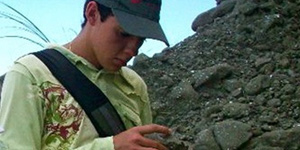by Juan Camilo Rojas
My name is Juan Camilo Rojas Echeverri and when I was a kid I dreamt of becoming a paleontologist and finding a huge dinosaur fossil. I started my major in biochemistry at Florida State University – Panama. During my time there, I had the opportunity to work under the guidance of Catalina Pimiento at the Smithsonian Tropical Research Institute (STRI).

At STRI, I had the chance to glance into the ancient past by searching for fossil sharks. The process of finding them begins with field trips, where stratigraphic information is used to determine which sites are more likely to contain fossils. With luck, it is possible to find large fossils like sea cow bones. More frequently, teeth and shells are fully exposed and can be easily collected. In the field, samples of sediment are excavated, stored in bags and brought back to the lab. Then begins the long screenwashing process where we place the sediments in sieves and fossils are washed off. Next, the matrix is taken to the lab where one can spend hours under the stereoscope looking for microfossils. Finally, the process of classification, and analysis of these tiny specimens begins.
My work at STRI allowed me to experience my childhood dream. I learned that achieving this dream requires effort, dedication and, more importantly, passion for what you are doing. My experiences also helped me understand the usefulness of paleontological and stratigraphical research to comprehend ancient ecosystems, earth’s climate and tectonics. Working with STRI has helped me grasp how real research is carried out. It has taught me that it is not easy and has prepared me to be a good researcher in my field.
In addition to my own work, the research of others, particularly the ones that integrate chemistry and paleontology, caught my attention. For example, by studying geochemistry, Dr. David Farris proposed that the emergence of the Isthmus of Panama was actually earlier than previously believed. Also, my mentor Catalina Pimiento, is using stable isotopes to reconstruct the life of the extinct Megalodon for her doctoral research.
Now that I have finished my second year as an undergraduate at FSU, it is time for me to leave Panama and move to the US to the FSU campus in Tallahassee. Even though I will not work at STRI, I will continue my scientific training with Catalina and the PCP-PIRE team. From FSU, it will be possible to continue work in paleontology and chemistry and to learn more about what it takes to reconstruct the past.
por Juan Camilo Rojas
Mi nombre es Juan Camilo Rojas Echeverri y cuando era niño soñaba con convertirme en paleontólogo y en encontrar un dinosaurio fósil gigante. Empecé mi carrera con énfasis en bioquímica en Florida State University (FSU- Panamá). Durante mi tiempo allí, tuve la oportunidad de trabajar bajo la orientación de Catalina Pimiento en el Instituto Smithsonian de Investigaciones Tropicales (STRI).

En STRI tuve la oportunidad de echarle un vistazo al pasado remoto a través de la búsqueda de tiburones fósiles. El proceso de encontrarlos inicia con salidas de campo, en los que la información estratigráfica es usada para determinar qué sitios tienen más probabilidad de tener fósiles. Con suerte, es posible encontrar grandes fósiles como el esqueleto de una vaca marina. Con mayor frecuencia, dientes y conchas están expuestos y pueden ser fácilmente colectados. Otra forma de encontrar fósiles es por medio del tamizado. Muestras de sedimento son colectadas en el campo, guardadas en bolsas y llevadas al laboratorio. Allí se inicia el largo proceso de tamizado donde ponemos los sedimentos en una serie de tamices donde se lavan. Luego, la matriz resultante se lleva al laboratorio donde uno puede durar horas bajo el estereoscopio buscando microfósiles. Finalmente, inicia el proceso de clasificación y análisis de los diminutos especímenes.
Mi trabajo en STRI me permitió experimentar el sueño de mi infancia. Aprendí que lograr este sueño requiere de esfuerzo, dedicación y pasión por lo que se hace. Mis experiencias también me ayudaron a entender la utilidad de la investigación paleontológica y estratigráfica para comprender los ecosistemas pasados, el clima de la tierra y la tectónica. Trabajar con STRI me ha ayudado a entender cómo se lleva a cabo la investigación, me ha enseñado que no es fácil, y me ha preparado para ser un buen investigador en mi campo.
Además de mi propio trabajo, la investigación de otros, particularmente los que integran química y paleontología, llamaron mi atención. Por ejemplo, a través de la geoquímica, el Dr. David Farris propuso que el surgimiento del istmo de Panamá fue en realidad antes de lo que se creía. También mi mentora Catalina Pimiento, está usando isótopos para reconstruir la vida del extinto Megalodón en su investigación de doctorado.
Ahora que terminé mi segundo año como estudiante de pregrado en FSU, es hora de dejar Panamá y mudarme a Estados Unidos al campus de FSU en Tallahassee. Aunque ya no trabajaré en STRI, continuaré mi entrenamiento con Catalina y el equipo del PCP-PIRE. Desde FSU será posible continuar trabajando en paleontología y química, y aprenderé más acerca de lo que se necesita para reconstruir el pasado.